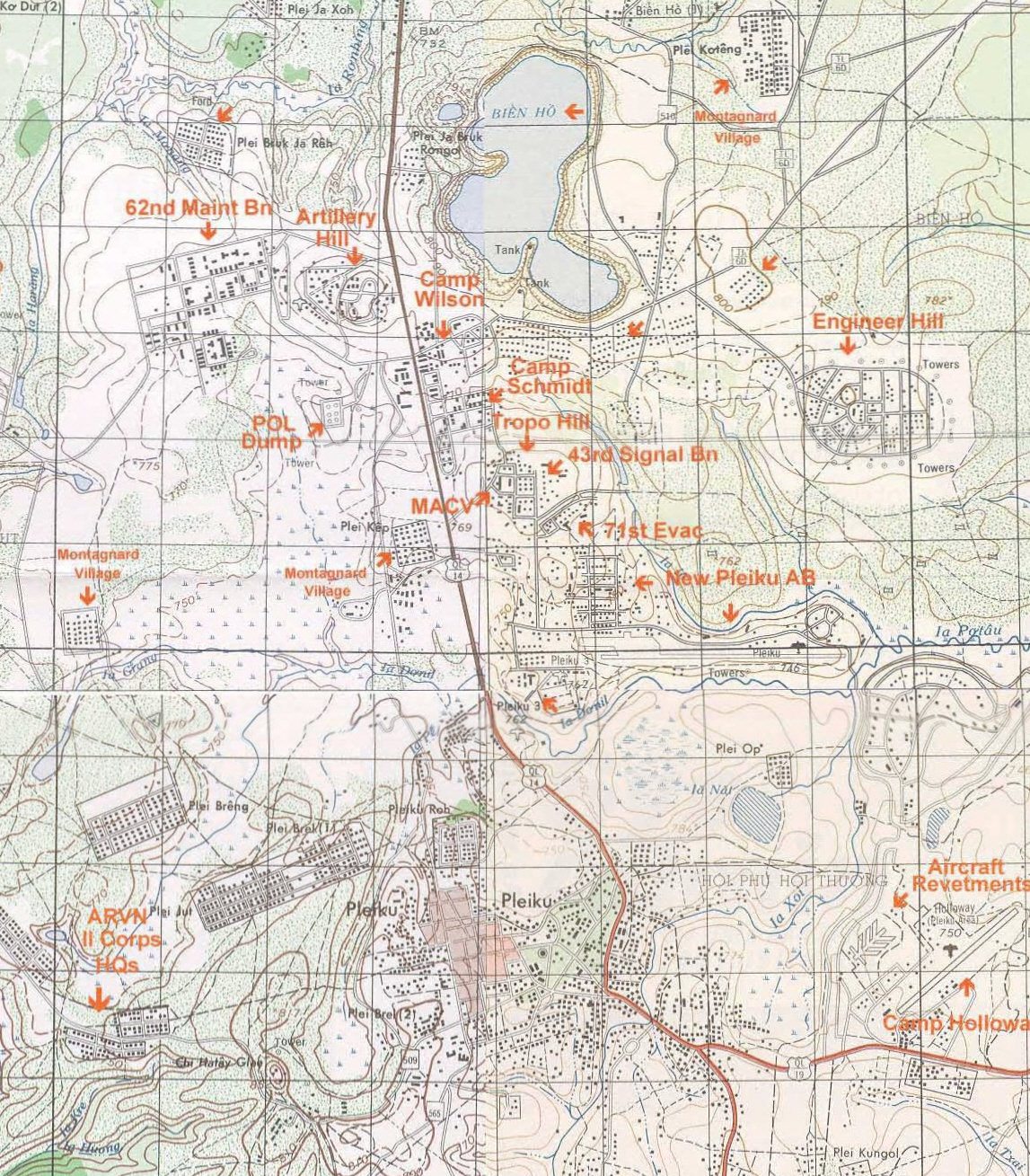
Courtesy of Danny Yates
BASE CAMP - THE MIGHTY NINTH
We reported for duty...but where?

Courtesy of Danny Yates
|
|
Courtesy of Joe Cook (Compare to photos at right) Base Camp, Jan 1966 |
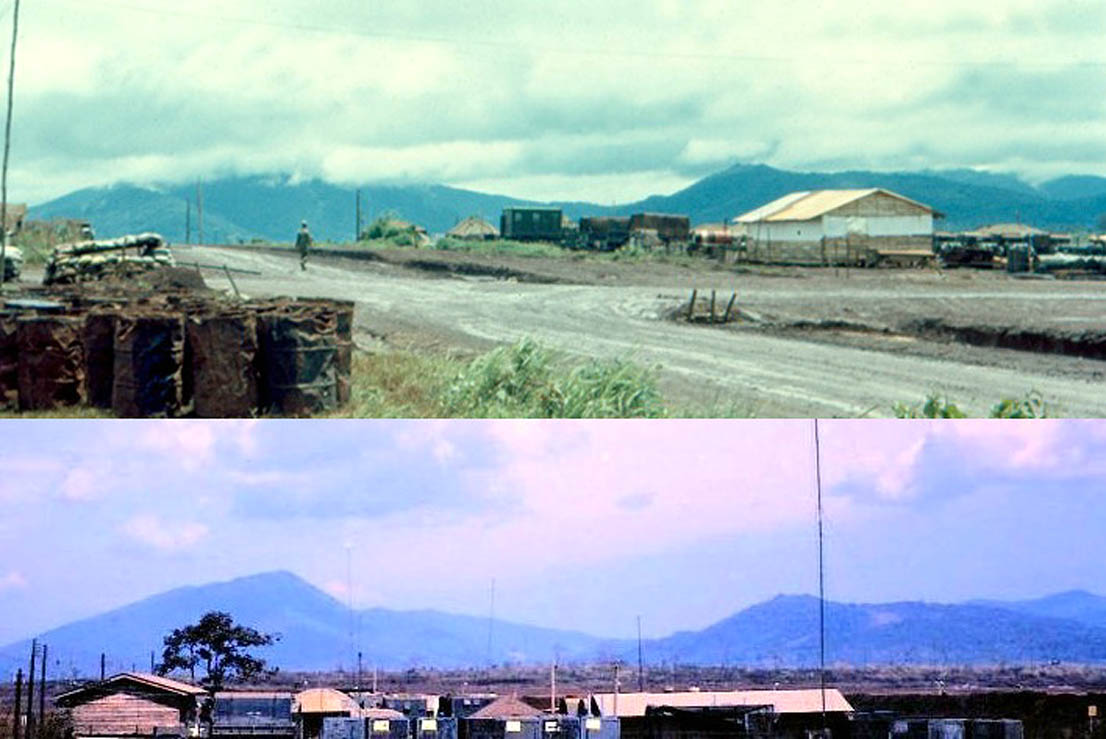 Courtesy of Danny Yates Note! Photo at Left, Photo above (2-parts) The skyline is identical! One of the photos was identified as "Engineer Hill" |
|
|
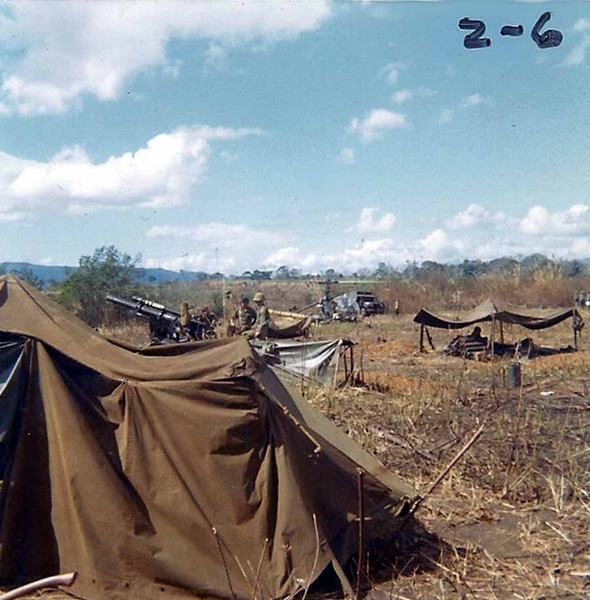 Courtesy of Joe Cook |
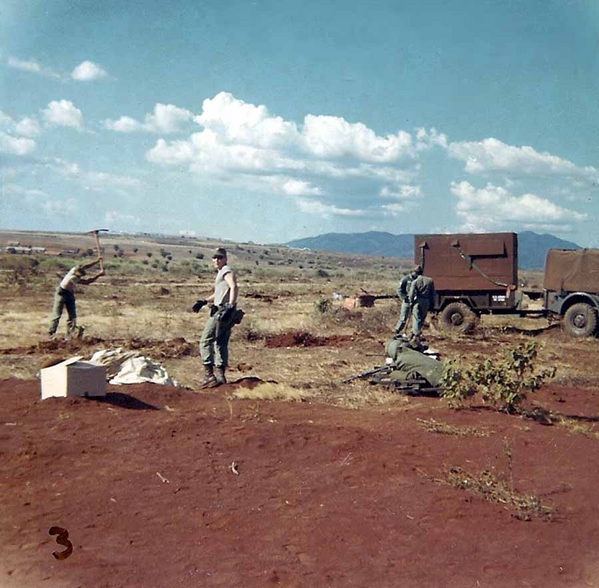 Courtesy of Joe Cook Base Camp; FDC Plywood Trailer |
Courtesy of Joe Cook |
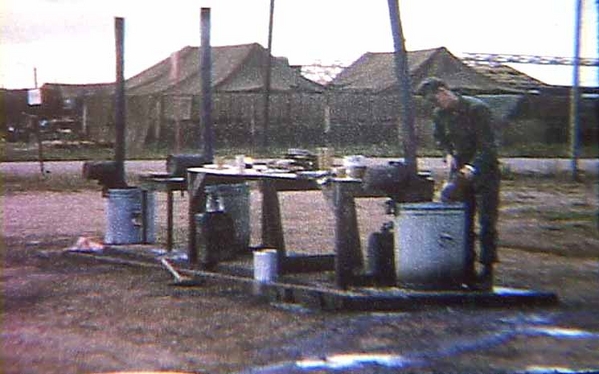 Courtesy of Edwin Moor |
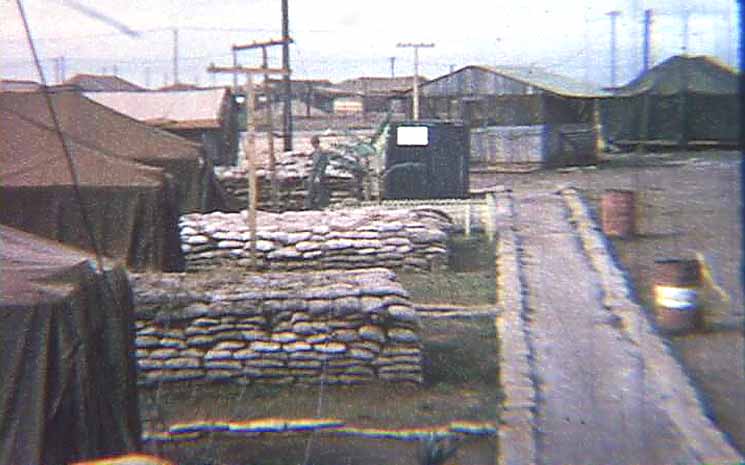 Courtesy of Edwin Moor |
|
|
|
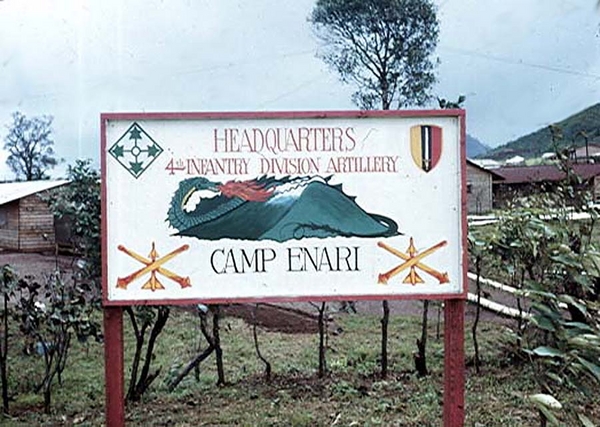
Courtesy of Don Keith |
|
|
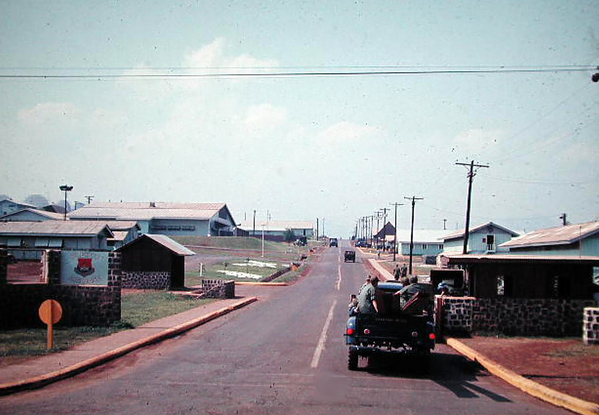 This is the 1969 era; much more developed Courtesy of Mike Kurtgis |
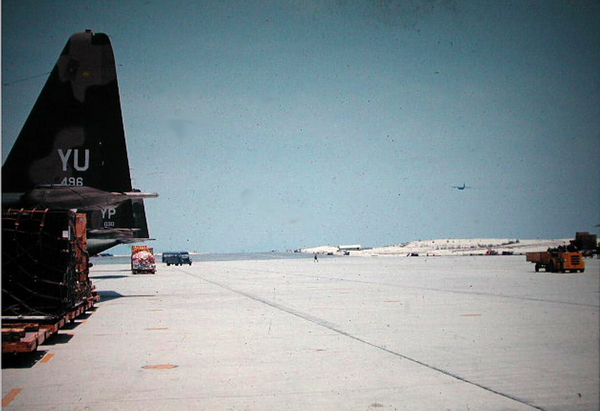 Pleiku AFB, 1969 Courtesy of Mike Kurtgis |
January, 2012
A question from Danny Yates concerning "the original base camp" at Pleiku yielded many responses. Since the question was posed to all who reside on our Email roster, I have decided to post all the responses I received. I am relying heavily on Sgt Joe Cook's notes, since he came over from Hawaii on "Operation Blue Light" and has photos of what he knows as the "base camp".
***********************************************************************************
Original Inquiry:
I need help finding our original base camp at Pleiku. In letters home, I mentioned that we were about 6 miles north of Pleiku, about where the current Pleiku Airport is. Iíve seen a lot of references to Camp Holloway, but I donít remember that name at all. I was never aware of the camp having a name. Did our base camp move in 1967? Iím hoping your memories are better than mineJ Thanks for your help.
Danny Yates
*****************************************************************************************************************************************
Danny adds this note later:
Iíve been looking into this since my first email on the subject. I think Iíve narrowed it down to a relatively small area. I found the attached map of the Pleiku area online (see top photo), a map labeled sometime after we were there. I then found a photo someone has posted about their time at Engineer Hill. I combined that picture with one of my own taken from our base camp (mine on top). I have other pictures taken in different directions so it should be fairly easy to locate our original base camp. Iíll be in Pleiku on March 27, 2012 to look around for myself.
Joe
Cook mentioned in his notes that our base camp was 3,000 meters north of Camp
Holloway. The map seems to support that observation. In letters
home, I mentioned that our base camp was 6 miles north of Pleiku. I also
said that the base camp moved in May, 1967, to a location south of
Pleiku, probably Camp Enari. Iíll be able to report more in a few
weeks.
{Webmaster
notes: check out and compare the photos in the 1st row of the table under
Danny's map}
********************************************************************************************************************************************
Joe
Cook provides excerpts from a letter home, January, 1966:"Base Camp", Pleiku. "Dad,
altitude of Our "B" Battery is 787 meters or 2,623 ft. We are on
a plateau and about 4,000 meters to the North of the town of Pleiku; its about
900 to 1400 meters in altitude."
First,
let me say I never heard of any other name except "Base
Camp" for name of rear area in Pleiku. I arrived January,
1966 (and rotated out after Christmas, January, 1967 ) with "B"
Battery of the 2/9th Field Artillery and attached to the 25th Infantry Division
in the FDC Section.
We
landed in a field (dirt runway) onboard a "Starlifter" C-141 aircraft,
near Pleiku and we convoyed from the dirt air strip to a field location about 5
miles to the North, Northwest. The 101st was performing perimeter
security duty until we offloaded (above the town of Pleiku area).
Then another new Infantry Unit (?) and us took security from the
101st and they left.
In
an open field we started building our bunkers outside the town of Pleiku,
near "Lake Bien Ho" (I think we needed to drive there to get to this
field). It would appear that we were building "Base
Camp" from January to February and then my unit was sent to the
boonies for the rest of the time and I never saw Base Camp again until I rotated
out. We spent first night in our pup tents around January
11, 1966. As you will see from my pictures, "Base Camp" in
Pleiku was NOTHING but dirt.
Another letter from Joe Cook after arriving on 10Jan66 - three days "in country": "Viet Nam is a pretty country. Our Base Camp is located on top of a ridge and we look out across a plain area. About 8,000 meters to the North, the mountains (actually high tree-covered hills) begin and go up about another 800 meters above our Base Camp". (Note. The estimated elevations could be all wrong or right as I do not remember how I came by the figures in this letter, although I was in the FDC and it was possibly part of my job to record this.) "The area we are in is clear and flat but as you get to the mountains, then lush vegetation begins. Around our Base Camp we have two villages and both are wired in and both laid out in similar pattern."
Joe
adds:
After living in "buddy-up" pup tents for a few days, we (the FDC of 5
men) then began
sleeping in a GP-small (with NO sandbags) which also housed our Chart
Tables, Radios, etc...until the bunkers were dug in. Yes - I am afraid
we were in no hurry and not fully aware of our danger, having just arrived from
Hawaii. Go Figure!
We
did bury two CONEX containers...size: 6'x10'x6' tall...face to face, with help
of a bulldozer in the Base Camp in January or February, 1966. I believe we had
red lighting (red bulbs) inside, which made it hard to read the charts (some of
charts were in red). Has anyone seen this or been in the CONEX'S? {Webmaster
replies: You bet your bippy, Joe! See the War Stories link: "An
Unlikely Hero"} My
point is there were no fixed
structures until around end of February or in March sometime that I am aware of.
Meanwhile, I am in the boonies for rest of year. A
quick aside: while in the boonies, we sent back to Base Camp ONE of our six
105mm howitzers into Base Camp. Thus each Battery sending ONE howitzer was to
form a "Battery" in the Base Camp area.
Another
letter home from Joe Cook: 1Feb66
I wrote home in a letter: Camp Holloway is 3 meters south of Base Camp, Pleiku Holloway has had fire for last 4 to 6 nights. We, at Base Camp, Pleiku are requested illumination
rounds over Holloway. (Note. The event happened before 1Feb66)
![]()
YOUR
COMMENTS:
Milton
Pounds:
"Wasnít
Camp Holloway the chopper base in Old Pleiku?"
Edwin
Moor:
"I
arrived in July of 66 and left in July of 67.
When I arrived,
there were a lot of men that had come over from Hawaii.
Like I said , it was on a hill
above the air base. I watched the base get mortared and found out that I really
like bunkers.
If you look at the first
six pictures
that I sent
(in
the Mighty Ninth
Photo Gallery) they are of the old
camp.
Danny Fort:
"I remember it being about 6 miles out northwest I think and it was called
camp Enari. That would have been in Sept 67-Sept 68. We flew into
the air strip in a C130 and took a 2 1/2 over to it and the same coming home.
There was a sign over the gate as you came in to the camp. I arrived
shortly after the switchover to the 4th Inf Div. We convoyed back there
from the coast to the highland and then again when we went Kontum."
Sam Nieto:"I
remember going south through Pleiku to the 4th Inf Headquarters about 4, 5, or 6 miles south, which was Camp Holloway. Could be that it was later move
north to the airport site. I remember the last two weeks volunteering
to deliver supplies to a camp east of Holloway near the border of Laos and
Cambodia. There is also a Camp Enari base camp of the 4th, so for sure
our base camp was south.
Michael
D. Huseth:
"Camp
Holloway was across the valley from the 3rd Brigade on the south side of
the Airbase. The 3rd Brigade was north and east of Pleiku, passed
the "MARS" station and then south of Engineer Hill. Brigade HQ
was in the center of the compound, "A" battery was on the north side
of the compound, "C" Battery was on the southwest corner overlooking
the valley and Dragon Mountain to the west of us (Charlie Battery) and
"B" battery was to the east side looking towards the mountain range
northeast of the compound.
Camp
Holloway was a drive through town and more permanent with a PX, Barber shop,
NCO, EM and Officers clubs. The barracks were Quonset huts with dividers
to make private rooms for the officers all heavily sandbagged. A couple
more senior NCO's would frequent the NCO club while I sat outside in the jeep
waiting. And I think there may have been an instance of Holloway
"losing" a jeep to someone not from Holloway.
The
Brigade got to VN in the latter days of December, 1965 (Operation Blue Light).
The hill was covered in brush and trees of sort, most all greenery was gone by
the time I arrived on 2 January, 1966. The AirCav and Camp Holloway
provided us the the air support we needed in the beginning. The tent kits
starting arriving in about February and we were then able to get off the ground
and stay relatively dry.
Bruce
Hulin:"At any rate according to Charlie Black, the camp was indeed called
"Holloway".
(From
Charlie Black, who was a War Correspondent at the time)
Ed
Thomas:"Yes,
Holloway is where we were until Enari was built and yes, it was where
the airport is now because we used that airport (actually they have
moved the new airport just up a mile from the old Holloway. We were there
last year.) Enari had another airport and it has since been closed as they have tried to wipe out anything that we had then (but we found
some
old
PCP planking from the Enari strip and had no trouble seeing
where it used to be, so it hasn't quite disappeared yet.) And yes,
they were on opposite sides of town."
Lee
Dixon:
"The
base camp that I recall was Camp Enari... which was rather quite large and then
there were a number of units clustered together. Barracks were mostly wood on
rough concrete by that time but there were lots of tents, too and I was in one
for a bit. Really messy in the rain and mud! The
old airport at
that time was quite a truck ride (or bus ride if you were lucky) away from
where we were and had Air Force guys there. They had very nice barracks,
incredibly cushy compared to what we had. I flew out of there all the
time.
I
was a member at the NCO Club at Enari and I used to go to the same PX as in Lt.
Springer's photos. When I first got to Enari in 1967, it was a terribly muddy
place with reddish mud and reddish dust everywhere. The 3rd Brigade 25th
and 2/9th's rear area was here and I remember the first guy I met smoked a lot
of cigarettes. He had a Jersey accent and listened to a lot of sha-boom
music on a dusty old audio unit in a wooden office covered in red
dust. 4th Division presence was huge here.
I honestly don't recall anything about the base moving and frankly toward the end I think I spent about a month right back where I started before shipping out ETS. I was all the way down to running switchboards by then because we had no radio teletype equipment or crypto in our immediate area. We always referred to this as the "rear area".
Dave Whaley: How about Brigade Hill? That's what I remember.
Webmaster
Dennis Dauphin - My Recall:
I have a postcard
home which confirms that I arrived in Cam Rahn Bay, Tan Son Nhut AFB in
mid-November, 1966. I have pictures posted in my Photo Gallery of Camp
Alpha, where I processed in-country. After a week of not knowing a damned
thing about where I would wind up, I got word to "move out". At
0430, I was directed to fly out to Pleiku.
Lt Frank Herbick was on the same flight. It was daylight where we landed, on a very basic dirt airstrip. There was
nothing in sight. This is likely the same airstrip where Lt Bert Landau
landed and dragged his duffel bag and went back for his wooden footlocker and
dragged that, too. A truck came by and saw me and Frank standing like two
Christmas ornaments in the middle of nowhere, wearing our
short-sleeved, stateside-pressed khaki uniforms with shiny Field Artillery
brass. Noticing our Artillery brass, they asked, "Are you looking for
the 2/9th Arty?" Yes, we were...but were they looking for us?
So we reported in to whatever-wherever...I was scared shitless by this
time...and all I can say is that it was primitive and it had tents. The
interview was short because they wanted us in the field...really bad!
Frank drew the 1st of the 14th and was immediately sent to the Ia Drang
Valley...Frank was lucky like that...and I drew the 2nd of the 35th. I
threw my duffel bag into a locker at this location. I never saw that
duffel bag until I was about to DEROS. I was informed that the locker area
got flooded due to the monsoon rains, so they moved it to another
location. This is how I know the camp got moved. When I finally
married up to my duffel bag, it was mostly mildewed goods. With my
"Freedom Bird" only a couple days away, you don't really think I gave
a crap where this was, do you? Sent some of the locker mildew home, tossed the rest out. Back to Tan Son Nhut, a seat on a Northwest
Airlines jet, and a ride to the states.
Finally, here is a contribution from Joe Hannigan about the naming of Camp Enari
The
Naming of Camp Enari
As
Colonel Jud Miller, commanding officer of the Second Brigade of the 4th Infantry
Division, completed preparations for leading his brigade from Fort Lewis,
Washington to Vietnam, Major General Arthur Collins, Division Commander, called
him to his headquarters to wish him luck and give him final instructions. Among
other things, Colonel Miller was to establish the base camp which the division
would occupy when they arrived later in the year.
"Jud,
I want you to name the base camp after the first GI killed by hostile fire after
you get to Vietnam. That would be a fitting tribute to a brave soldier",
said General Collins in his parting instruction as Colonel Miller left on that
day in July, 1966 to board the plane taking the advance party to the division's
new home south of Pleiku, Vietnam.
On
September 3, 1966, while operating on a search and destroy mission as a member
of Charlie Company, First Battalion, 22nd Infantry regiment, PFC Albert Collins
became the first Ivy Division soldier killed in action when he was cut down by
heavy fire from a Vietcong unit.
Knowing
that General Collins would not want it to be perceived that the base camp was
named after him, Colonel Miller sent a back channel message to General Collins
at Fort Lewis explaining his proposed alternative plan for naming the base camp.
"Since the first enlisted man killed in action was named Collins, I
recommend we name the base camp after the first officer killed in action."
General Collins agreed with Colonel Miller's recommendation.
On
November 5, 1966, while participating in Operation Paul Revere IV with Alpha
Company, First battalion, 22nd Infantry Regiment, Lieutenant Richard Collins,
graduate of the West Point class of 1965, became the first Ivy Division officer
killed in Vietnam when he was shot by a dug in North Vietnamese force. By now,
General Collins had arrived in Vietnam and discussed the dilemna with Colonel
Miller. "We'll name the base camp after the first posthumous recipient of
the Silver Star, regardless of his name or rank," was the agreed to plan.
Lieutenant Mark Enari had worked on the Second Brigade staff and was constantly prodding Colonel Miller to let him go to a line company to lead a rifle platoon. As a replacement was needed in the First Battalion, 12th Infantry regiment, Lieutenant Mark N. Enari earned the Silver Star while fighting the North Vietnamese regulars during Operation Paul Revere IV in the Central Highlands of Vietnam. Lt. Enari died as a result of the wounds he received during that battle.
Early
in 1967, the Fourth Infantry Division's base camp, sitting at the foot of Dragon
Mountain in the Central Highlands of Vietnam, was named Camp Enari in honor of
Lieutenant Mark Enari and retained that name as long as American forces were in
Vietnam.